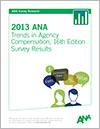 The role of procurement departments in determining agency compensation has grown dramatically in just two years, and is now the biggest part of client organizations involved
in determining the way their ad agencies are compensated, according to the just-released 2013 edition of the Association of National Advertisers’ Agency Compensation Survey.
The role of procurement departments in determining agency compensation has grown dramatically in just two years, and is now the biggest part of client organizations involved
in determining the way their ad agencies are compensated, according to the just-released 2013 edition of the Association of National Advertisers’ Agency Compensation Survey.
The study finds that procurement departments now play a role in 82% of agency compensation decisions, up from only 56% in the ANA’s 2010 survey. While brand management teams still are
an important factor in those decisions, only 67% of this year’s survey respondents cited brand management as being involved in those decisions. While that is up from 47% in 2010, it shows that
compensations decisions are being influenced more by process than relationships, per se.
advertisement
advertisement
The client’s ad department is the next most influential source of compensation
decisions, cited by 58% of respondents this year, vs. 56% two years ago.
While newer methods of compensation are “gaining a foothold,” fee-based compensation models
remain the overwhelming norm for marketers to pay their ad agencies, according findings of this year’s survey, which is based on responses from 98 marketers, including Aflac, Ford, General
Mills, Verizon and Visa, found 81% of client organizations still compensate their agencies with some sort of fee, most often a labor-based one.
In fact, labor-based fees, which
usually prorate the costs of full-time employees (or FTEs) necessary to service an account, rose to 65% of respondents from 49% just three years ago, and is now considered the “leading”
trend, according to the ANA.
“While the main types of compensation have not changed, the reasons for marketers to adjust their compensation approaches have,” the ANA
noted, adding, that nearly 40% of marketers cited the need to improve their agency’s performance as the primary reason for altering their compensation methods.
That’s a
healthy trend for agencies, the ANA said, noting that “cost-cutting is no longer the driver behind change.” The percentage of respondents citing cost-cutting as the reason for changes in
agency comp, declined 13% over the past three years.
Not surprisingly, there has been a corresponding uptick in the share of marketers utilizing “performance incentive”
models of compensation. Nearly two-thirds (61%) now utilize some form of incentive, up from 46% in 2012. The ANA said performance incentives are most popular among “larger
advertisers.”
Among those marketers utilizing performance models, 75% measure it via some form of “performance review, with measures of improvements in “brand
awareness” (71%) and achieving “sales goals” (52%) being among the most prevalent bases.
Not surprisingly, the vast majority of marketers (82%) now use a procurement team to
review agency compensation, compared with only 56% in 2010.